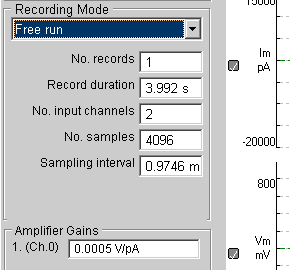Recording Experimental Signals > Setting the Recording Sweep Size and Duration
 When Free Run, External Trigger or Detect Events recording modes are selected, the number of analog input channels, number of sweeps, the number of digital samples per channel and the recording sweep duration need to be set in the recording window. (Note, in Stimulus Protocol mode, these are set in the protocol.)
When Free Run, External Trigger or Detect Events recording modes are selected, the number of analog input channels, number of sweeps, the number of digital samples per channel and the recording sweep duration need to be set in the recording window. (Note, in Stimulus Protocol mode, these are set in the protocol.)
No. records: Sets the number of recording sweeps to be collected
No. input channels: Sets the number of analog input channels to be acquired. Channels are always acquired in sequence from Ch.0 upwards, i.e. No. input channels=1, selects Ch.0; No. input channels=2 selects Ch.0 & Ch.1 etc.
Record duration: Sets the required duration of the recording sweep. Set the duration to a value that is approximately 50% longer than the time course of the signals that you intend to record.
No. samples: Sets the number of samples to be acquired per input channel. The minimum is 256 samples per channel and increments are in units of 256. The maximum ranges from 16184/No. Channels - 1048576/No. Channels, depending on the laboratory interface in use.
Sampling Interval: The Sampling interval box displays the time between digitised samples acquired from each analog input channel. It is determined from

Entering a value into the Sampling interval box, will result in an adjustment of the Record duration.
It is important to use a sampling interval which is small enough to ensure that a sufficient number of samples are acquired during the most rapidly changing phases of the signals being recorded. For most types of signal, 2048 samples/channel and a record duration approximately 50% longer than the signal time course provide satisfactory results. (However, note that some signals, such as cardiac ventricular action potentials, can combine long time courses (200-300 ms) with very rapid rising phases (1-2 ms). In such circumstances, 8192 or more samples/channel might be required to accurately represent the rising phase.)
To avoid aliasing artefacts, the analog signals should be low-pass filtered to remove frequency components greater than half of the sampling rate (i.e. reciprocal of the sampling interval).